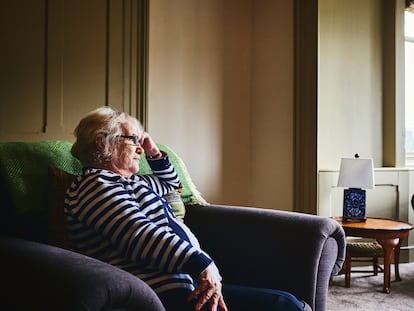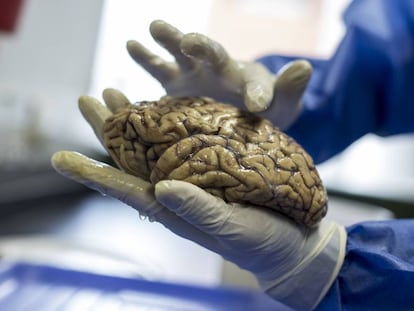Carolyn Lam, cardiologist: ‘With a heart attack, a woman has a higher risk of dying than a man’
The specialist from the National Heart Center of Singapore warns of the effects of the gender gap in cardiovascular health: women receive fewer treatments and some drugs have only been studied for men

Heart disease “is just not sexy,” reflects cardiologist Carolyn Lam. It is not fashionable. It is not talked about. Despite being the first cause of death in the world, both in men and women, people do not regularly monitor their blood pressure or sugar levels, even if those variables can influence cardiovascular risk, warns the specialist, who talked with EL PAÍS during a symposium on heart failure organized by the pharmaceutical company Bayer in Barcelona, Spain.
Lam, the director of Women’s Heart Health at the National Heart Center of Singapore, highlights the lack of awareness of these ailments, especially among women: it often happens, she explains, that women do not even accurately identify the symptoms of a heart attack, which can be different from those of men; aside from chest pain (which they may or may not experience), women also suffer from neck pain or tightness in the jaw.
Question. We tend to associate cardiovascular diseases more with men.
Answer. Yes. But we should change that. It is just as much a woman’s disease. One in three women die of heart disease and stroke, but also one in three men. It’s the top killer for both, men and women. But we keep ignoring the women, which must change.
Q. Is the scientific community aware of the differences between sex and gender in this type of disease?
A. We don’t know everything, but we know a lot more. And by the way, when you said sex and gender — that is exactly correct. Sex is biological sex, hormones. Gender also plays a part. Gender is our social rules. For a long time there was a misconception that women are protected from heart disease because of estrogen, because of our sex hormones. Why did we think that? Because in the younger age groups, it’s true that men get more heart disease. But as we go, older women also, especially after the menopause, also get heart disease and in fact can overtake the men. But if we only look at the younger women and the younger men, we get this wrong idea. We have learned, but it was from assumptions.
Just like in the movie Yentl, the woman, in order to be taken seriously, had to look like a man. That’s the problem with symptoms. It’s almost as if we need to experience it like a man and describe it like a man before we are taken seriously. Bernadine Healy, MD, used the term “Yentl syndrome” in 2001 to draw attention to the paradox of adverse outcomes for women with ischemic heart disease, as well as underdiagnosis and undertreatment of women. Yentl syndrome is the different mechanism of action that heart attacks tend to follow in women compared to men. This is a problem because much of the medical research has focused primarily on the symptoms of heart attacks in men, and many women have died due to misdiagnosis because their symptoms present differently.
Q. Are the symptoms not the same?
A. Men often feel chest pain, central chest pain. A woman can also have chest pain, but more often than in the men, it’s non chest pain but jaw pain, jaw tightness. Many people think it is actually toothache, or they keep saying they’re tired, or they feel it in the stomach or the back. And women rationalize it: instead of saying, “Oh, something is not right,” they go, “Oh, I ate too much, I’m too stressed. I don’t know, it must be menopause.” Men get chest pain and say, “I think it’s the heart, I better see a doctor.” Women say, “I think I need to go to a spa.”
Q. Is it a matter of education, then? When faced with pain, there will be a bias and women will be told that it is anxiety or some mental health problem.
A. That’s the problem. The men will come [to consultation] and say: “I have chest pain. Please check my heart.” The women will come and say: “Oh, sorry to disturb you. I think I’m stressed because my son has an exam and my dad...” They apologize; they don’t say it is the heart.
Q. What is the doctor’s responsibility in this regard?
A. I think we are all responsible. The doctors need to remember that women can have heart disease and can have different symptoms, but the patients also need to feel entitled to have heart disease and help the doctor understand that this is serious. I think we just all need to come together. It starts when you’re younger. I grew up with my mother, who is a doctor. She was always chasing my father so that he would check his cholesterol, check his blood pressure. Check, check, check. But never her. We take care of everybody, and we imagine that we are protected, but we are just as vulnerable.
Q. The scientific community has long known about these gender differences. Has anything changed in recent years?
A. I think that a lot has improved. There have been attempts to make women aware of our own risk. So that is good. Another thing that’s been impeding progress is the fact that we don’t have enough women in clinical trials.
Q. Why is that?
A. They don’t prioritize themselves. Sometimes it’s very hard to get women to come to the trials, so [they] are always underrepresented. And then, you know, our earliest trials were all men. They only studied male mice, because they didn’t want the complications of the pregnancy or whatever, so they didn’t even study female mice. How can we go on like that, systematically excluding women? Now things have improved: for example, our heart failure trials now have 40% [or] 50% women.

Q. Are there any medical treatments or procedures whose efficacy in women is not known because the trials were done in men?
A. Yes, there are unfortunately quite a few examples where there is a difference. In heart failure, there’s a drug called digoxin, it’s very old, but we didn’t realize until much later that there is a sex difference in the response: the same dose gets higher levels of the drugs in women than men, and it is associated with toxicity and more deaths in women compared to men. And there are some medications that we simply give women the doses that we know in men.
Q. What is the consequence of these types of inequalities? Being a woman, am I more likely to die than my male partner, for example?
A. Yes. Our data still shows that with a heart attack, a woman has a higher risk of dying than a man. And a woman still receives less invasive therapies. And a lot of the medications that we have, they are less likely to receive them than men. There are many, many reasons.
Q. Such as?
A. For example, a woman who has a heart attack could have small vessel disease. Not the big vessels, but the small vessels. And with the small vessels you cannot put a stent. And sometimes [the small vessel disease] is missed and undertreated. Another reason is that women who suffer a heart attack can be older than the men. You’ve got more of the other things, like hypertension, high blood pressure and so on. However, we adjust for age, and we still find women with a heart attack do worse than a man.
Q. What needs to be done to close this gap?
A. What we are doing right now: trying to educate the public is extremely important. A woman must recognize her own risk. No excuses. So just as much as the boyfriend, the father, the brother, everybody else needs to take care, know their numbers, we must know our own. Do you know your blood pressure? Do you know your cholesterol? These are all risk factors for heart disease.
Q. Cardiologist Valentín Fuster told EL PAÍS: “We live in a consumer society that deprives us of what is important, which is quality of life.” He also said that cardiovascular risk factors are a mirror of life. What do you think?
A. Yes, I think cardiovascular disease is largely a lifestyle disease. That’s a good and a bad thing. The bad thing is that it’s so sad that it’s something we actually do to ourselves. We clog our own arteries with fat and smoke and problems. We don’t take care of what nature has given us. But the good part is that it is modifiable. If it is a lifestyle disease, it means we can try to do something about it. Stress management is very, very important these days. The woman’s heart-brain connection is even stronger. Stress can literally give you a heart attack. It’s called broken heart syndrome. So part of it is our stress management; we need to have good mental health.
Q. But does this only happen to women?
A. It happens to women and men, but that that connection between the emotions and stress and heart disease is very strong in women. There is this syndrome, as I said, called broken heart syndrome, where a woman hears a very bad piece of news, and she has a heart attack — not because the arteries are filled with fat, but because the stress makes the arteries literally constrict, and they get a heart attack even when the arteries are clear. It happens predominantly in postmenopausal women, and much more than men.
Q. Does sleep influence cardiovascular health?
A. Yes, sleep is often ignored, but it’s a very important part of a good lifestyle management. When we are sleep-deprived for hours, our whole body is in a state of adrenergic high. And it affects a lot, it actually affects our metabolism and our eating patterns as well. It’s a very bad downward spiral: your stress hormones are very high, and it causes you to want to eat unhealthy things. Then the stress makes your blood pressure go up. You can get high blood sugar as well. So, you know, it is very, very important. For our rest, our peace, our mental health.
Sign up for our weekly newsletter to get more English-language news coverage from EL PAÍS USA Edition
Tu suscripción se está usando en otro dispositivo
¿Quieres añadir otro usuario a tu suscripción?
Si continúas leyendo en este dispositivo, no se podrá leer en el otro.
FlechaTu suscripción se está usando en otro dispositivo y solo puedes acceder a EL PAÍS desde un dispositivo a la vez.
Si quieres compartir tu cuenta, cambia tu suscripción a la modalidad Premium, así podrás añadir otro usuario. Cada uno accederá con su propia cuenta de email, lo que os permitirá personalizar vuestra experiencia en EL PAÍS.
¿Tienes una suscripción de empresa? Accede aquí para contratar más cuentas.
En el caso de no saber quién está usando tu cuenta, te recomendamos cambiar tu contraseña aquí.
Si decides continuar compartiendo tu cuenta, este mensaje se mostrará en tu dispositivo y en el de la otra persona que está usando tu cuenta de forma indefinida, afectando a tu experiencia de lectura. Puedes consultar aquí los términos y condiciones de la suscripción digital.
More information
Últimas noticias
Most viewed
- Reinhard Genzel, Nobel laureate in physics: ‘One-minute videos will never give you the truth’
- Oona Chaplin: ‘I told James Cameron that I was living in a treehouse and starting a permaculture project with a friend’
- Pablo Escobar’s hippos: A serious environmental problem, 40 years on
- Chevy Chase, the beloved comedian who was a monster off camera: ‘Not everyone hated him, just the people who’ve worked with him’
- Why we lost the habit of sleeping in two segments and how that changed our sense of time











































